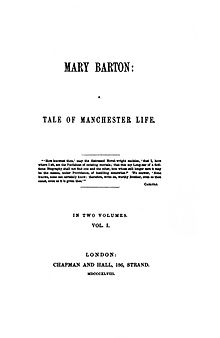 First edition title page | |
| Author | Elizabeth Gaskell |
|---|---|
| Language | English |
| Genre | fiction |
| Publisher | Chapman & Hall |
Publication date | 1948 |
| Publication place | UK |
- For Gaskell's intro: http://books.google.co.uk/books?id=qqROAAAAcAAJ&printsec=frontcover&dq=criticism+%22mary+barton%22&hl=en&sa=X&ei=mlOhT6GgJYnM0QXi-ImgCA&ved=0CC8Q6AEwAA#v=onepage&q&f=false
- Thomas Seccombe's introduction: http://books.google.co.uk/books?id=NQudH9O28OwC&pg=PR12&dq=criticism+%22mary+barton%22&hl=en&sa=X&ei=mlOhT6GgJYnM0QXi-ImgCA&ved=0CDUQ6AEwAQ#v=onepage&q=criticism%20%22mary%20barton%22&f=false
- 'Mary Barton, when all deductions are made, is one of the greatest novels of compassion our country has ever produced. It ranks Mrs Gaskell with Goldsmith, Hood, Dickens and Mark Rutherford as one of the truest and most pathetic protectors of the poor.' (xii)
- received £100 outright for Mary Barton (contrasted with £2000 for Wives and Daughters, her last) (xiii)
- Brian Cooney, 'Volience, Terror, and the Transformation of Genre in Mary Barton': http://books.google.co.uk/books?id=Ct5ACjcD8egC&pg=PA29&dq=criticism+%22mary+barton%22&hl=en&sa=X&ei=mlOhT6GgJYnM0QXi-ImgCA&ved=0CDwQ6AEwAg#v=onepage&q=criticism%20%22mary%20barton%22&f=false
- criticism in shift of genre from the 'grand social critique' to 'domestic' -- Raymond Williams, on the early chapters, 'the most moving response in literature to the industrial suffering of the 1840s'; later chapters, 'familiar and orthodox...Victorian novel of sentiment' -- RW suggested that the shift might have been due to pressure from her editors -- says that Gaskell put Barton beyond her own sympathies in making him a murderer (29)
- Originally entitled John Barton - critics use this as a metonomy for the altered genre
- Kamilla Elliott (in contrast with Williams): 'It is the romance plot, not the political plot, that contains the more radical political critique in the novel'
- passivity - factory fire scene - doesn't fulfil the domestic role (i.e. Mary discovering her true feelings for Jem) but rather a political one, showing passivity of the watching crowd, echoed in silence of the crowd as the individual acts (30)
- ed. Chapman, Alison Icon Critical Guide to Mary Barton and North and South: http://books.google.co.uk/books?id=tqRmC6_u-HAC&printsec=frontcover&dq=%22mary+barton%22+gaskell&hl=en&sa=X&ei=EUuiT_u0EMa80QXnoIHDCA&sqi=2&ved=0CF8Q6AEwCA#v=onepage&q&f=true
- contemporary critics debted whether she was a 'radical or dangerous sympathiser with the poor' (7)
- Richard Gravil: http://books.google.co.uk/books?id=7rrj1ngZsOAC&printsec=frontcover&dq=%22mary+barton%22+gaskell&hl=en&sa=X&ei=EUuiT_u0EMa80QXnoIHDCA&sqi=2&ved=0CGQQ6AEwCQ#v=onepage&q=%22mary%20barton%22%20gaskell&f=false
The Odd Women
editGeorge Gissing: The critical heritage, Pierre Coustillas
edit(Unsigned review, Glasgow Herald, dated 20th April 1893) http://books.google.co.uk/books?id=idD75Ec6yZkC&pg=PA215&dq=the+odd+women+george+gissing&hl=en&sa=X&ei=SMOuT6_dIIfX0QW0vbnKCA&ved=0CEIQ6AEwAw#v=onepage&q=the%20odd%20women%20george%20gissing&f=false